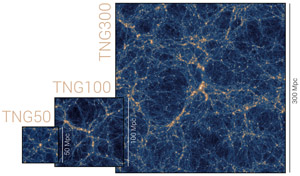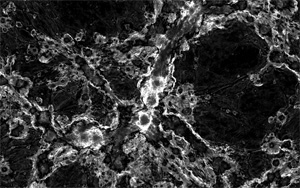Media Images, videos, and other visualizations.
Note: that everything on this page is intended for public distribution. Anyone is welcome to download, distribute, and share images/videos presented here. For presentation in talks, posters, a text credit to the "TNG Simulations" or "TNG Collaboration" is sufficient.
For any commercial (non-academic) uses please contact us first.
TNG50 Images:
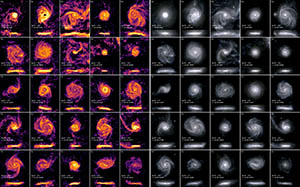
A. Pillepich, D. Nelson
An ensemble of twenty-five highly disk galaxies from TNG50 at z=2. The view on the left shows light emitted in the H-alpha line from interstellar gas as a result of ongoing star-formation, while the panels on the right shows the optical light emitted by a mix of young (bluer) and old (redder) stars. Each galaxy can be seen rotated edge-on below its face-on view. [large] [ref]
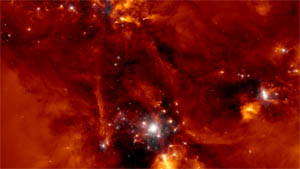
D. Nelson
A forming proto-cluster region in TNG50, where the hierarchical assembly of this massive object proceeds as dark matter structures (in white) progressively collapse and merge together. At the same time, vigorous feedback processes from supernovae and supermassive blackholes combat the inflows of cosmic gas into these gravitational wells, resulting in a complex interplay of structure in gas motions (velocity field in red). [large]

D. Nelson
The same proto-cluster region of TNG50 two and a half billion years later, just after redshift one. By this time two massive galaxy groups have formed, made up of large dark matter halos (orange) connected by a bridge of tenuous dark matter bridge (blue). High speed gas motions (in white) reveal ram-pressure and tidal stripping of orbiting satellite galaxies, as well as galactic-scale outflows driven by feedback. In ten billion more years of evolution, these two cores will coallesce into a galaxy cluster with a mass exceeding one hundred trillion times the mass of our sun. [large]
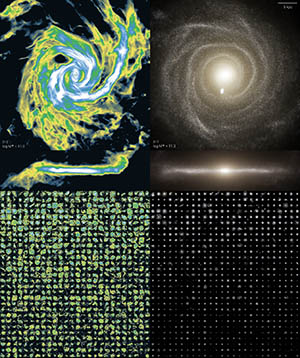
D. Nelson
The gaseous (left) and stellar (right) structure of TNG50 galaxies at high redshift. The top shows a massive disk galaxy at z=2 and a descendant at z=1, while the bottom montage reveals ~750 central galaxies at redshift two, from large ellipticals at the center of galaxy groups to smaller, dwarf systems. [large] [ref]
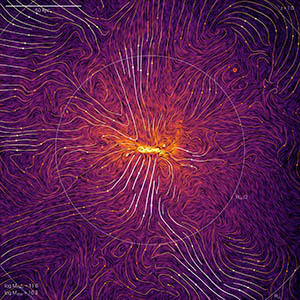
D. Nelson
The topology of halo-scale gas flows around a single TNG50 system, similar in mass to a Lyman-break galaxy. Streamlines of gas motion are overlaid on a line-integral convolution image of gas density modulated by its velocity field. Outflows emerge collimated from the central galaxy traverse half the virial radius (dotted circle), producing small-scale vortical motions as well as a large-scale, circulatory, galactic-fountain type flow confined within the halo virial radius. [large] [ref]
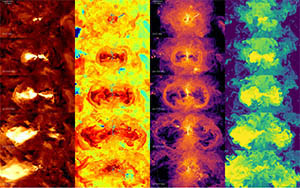
D. Nelson
Emergence and time-evolution of a collimated, bipolar, halo-scale outflow driven by supermassive blackhole feedback from a central galaxy (seen roughly edge-on in the very center). From left to right columns show: gas velocity, temperature, density, and metallicity. Rows progress in steps of ~100 million years each, from top to bottom. Energy injection from the central blackhole within the innermost 150 parsecs produces a high-velocity, large-scale directional outflow, reaching more than 2500 km/s as it crosses the virial radius (shown as circles in the final row). This flow heats two centrally offset lobes to temperatures of one hundred million degrees Kelvin. These underdense cavities expand outwards, sweeping up gas into shells and dragging metal-enriched gas from the central galaxy into the halo and out to the intergalactic medium. [large] [ref]
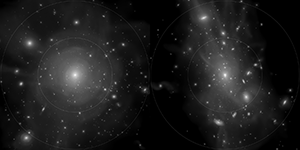
D. Nelson, G. Joshi
The two most massive halos in TNG50 at redshift zero, both of which are galaxy clusters with total masses 100 trillion times the mass of the Sun. The image show the distribution of stars, from the bright central galaxy, to the extended distribution of the intracluster light, to the many satellite galaxies which are hosted within the virial radii (outer circle). These satellite galaxies transform their shapes from disk-like to spheroid-like due to interactions within the cluster. [large] [ref]
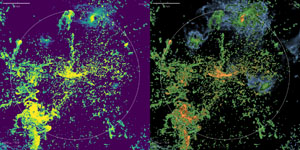
D. Nelson
Cold gas in the circumgalactic medium (CGM) of a massive halo at z=0.5, which hosts an elliptical, 'luminous red galaxy' (LRG) at its center. Although the dark matter halo is filled with a hot plasma with a temperature of ~10,000,000 degrees Kelvin, it is simultaneously filled with tens of thousands of small, cold gas clouds, as seen in singly ionized magnesium (left) and neutral hydrogen (right), one thousand times colder, exemplifying a multi-phase structure. [large] [ref]
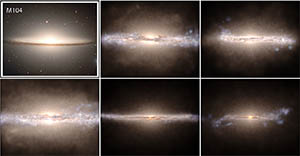
A. Pillepich, V. Rodriguez-Gomez, M. Du
The real Sombrero Galaxy (M104), top left panel, and five simulated analogs from the TNG50 simulation. M104 is an example of a galaxy with a large, classical central "bulge", which may be better thought of as a "stellar halo" according to a kinematic definition. The top left is a composite image of V, R, I-bands from FORS1/VLT, while the other panels showcase synthetic images of TNG50 galaxies generated with the radiative transfer code SKIRT. Unlike the real Sombrero galaxy, the simulated objects are shown perfectly edge-on and across a somewhat larger field of view of ~70 kpc. [ref]
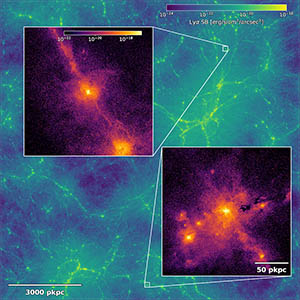
C. Byrohl
Surface brightness map for the entire TNG50 simulation at z=3, highlighting the large-scale structure of the cosmic web as seen in the Lyman-alpha emission line of hydrogen. The inset panels show two individual LyA halos. LyA photons are predominantly emitted in the star-forming regions of the central galaxies, resonantly scatter and illuminate the more extended gaseous halos, including filamentary inflows. [large] [ref]

D. Nelson
The energy dissipation rate of large-scale cosmic shocks across the TNG50 simulation. The filaments and sheets of the cosmic web are revealed as hydrodynamical shocks form at their boundaries. At the same time, feedback processes within galaxies drive large, megaparsec-scale quasi-spherical bubbles outwards from their centers. [large]
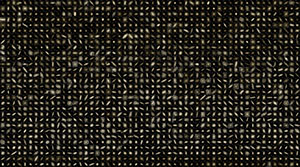
D. Nelson, V. Rodriguez-Gomez
Gallery of synthetic stellar light images of TNG50 galaxies at redshift zero. Dust obscuration and scattering is accounted for by radiative transfer post-processing. This reveals the existence of dark dust lanes, particularly when galaxies are nearly edge-on, where the optical light emitted by stars is absorbed by dust and re-emitted as infrared radiation. [large] [ref]
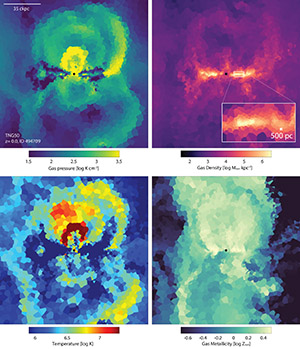
A. Pillepich
A outflow-driven "bubble" produced by supermassive black hole feedback, around a disky galaxy similar to our own Milky Way at redshift zero, found within the TNG50 simulation. This structure is similar to those observed in gamma-rays by the Fermi telescope, and in x-rays by the eROSITA mission, in our own Galaxy. [large] [ref]
Images:
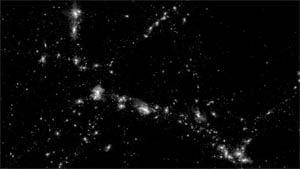
D. Nelson
The stellar content of the Universe on the largest scales: a projection of the distribution of stars across a 50 Mpc region of space. Taken from the TNG100-1 simulation at the present day (z=0). [large]
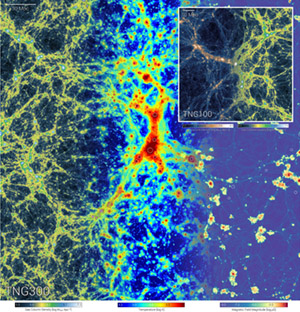
D. Nelson
Overview comparison of the TNG100 and TNG300 simulations at redshift zero (present day). Three views of TNG300-1 centered on the most massive cluster in the box: gas density (left), gas temperature (center), and magnetic field amplitude (right). The 50 most massive halos are indicated by circles. In the inset in the upper right, we show the TNG100-1 volume in dark matter density (left) and gas density (right). [large]
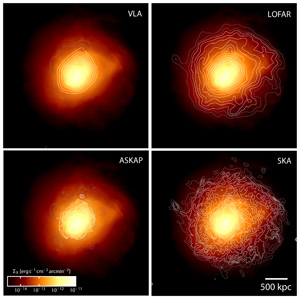
F. Marinacci
X-ray map (in color) overlayed with synchrotron emission contours for the most massive halo of the TNG300-1 simulation. The panels are 3.5 Mpc on a side, each of the four representing a hypothetical observation by a different radio telescope (current or future). [large]

D. Nelson
TNG100-1: Fullbox composite which combines gas temperature (as the color) and shock mach number (as the brightness). Red indicates 10 million Kelvin gas at the centers of massive galaxy clusters, while bright structures show diffuse gas from the intergalactic medium shock heating at the boundary between cosmic voids and filaments. [large]
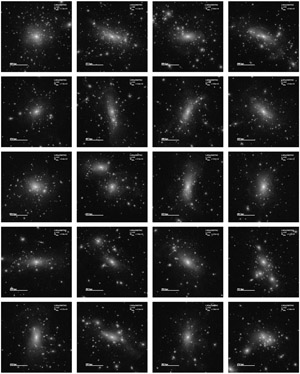
A. Pillepich
Ensemble of the extended intracluster light (ICL) of the twenty most massive clusters in TNG300-1 at redshift zero (present day). This diffuse component of stars arises as satellite galaxies fall into the cluster and are subsequently tidally disrupted. [large]

D. Nelson
Mock stellar light images of two galaxy samples: blue, star-forming systems (35 galaxies on the left) versus red, quenched systems (35 galaxies on the right). Both are taken from the same halo mass bin (12.0 - 12.2 total mass) in TNG100-1 at redshift zero. Imaged in JWST NIRCam f200W, f115W, and F070W filters (face-on). Each panel is 60 kpc on a side.
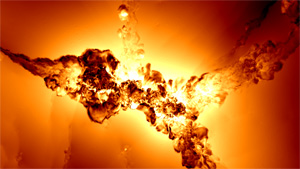
D. Nelson
Render of the gas velocity on 10 Mpc scales, although only in a very thin slice of 100 physical kiloparsecs (in the viewing direction). Where the image is black, the gas is hardly moving, while white regions have velocities which exceed 1000 km/s. Centered on the second most massive cluster in TNG100-1 at z=0, gas motions in cosmic filaments are contrasted against the fireball of the deep gravitational potential sitting at their intersection. [large]
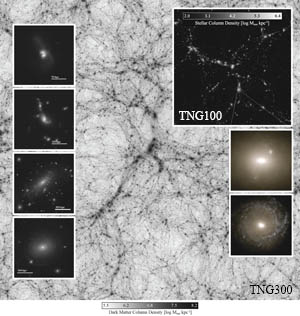
A. Pillepich
Composite image of the TNG300 and TNG100 simulations: in the background, the full dark matter map of the large TNG300 volume, the backbone of structure formation. In the upper right inset, the distribution of stellar mass across the full ~100 Mpc TNG100 volume. Panels on the left show galaxy-galaxy interactions and the fine-grained structure of extended stellar halos. Panels on the right show stellar light projections from two massive central galaxies at the present day. [large]
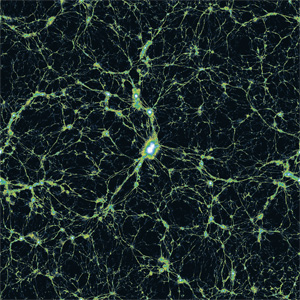
D. Nelson
Gas column density across the full large-volume TNG300-1 simulation at redshift zero. We center on the most massive cluster in the box, which emerges as a 10 Mpc scale gas overdensity in the center of this image. Otherwise, the homogeneity of large-scale structure begins to emerge across the extent of this volume. Here a thin slice of only 100 kpc in depth is shown. [large]
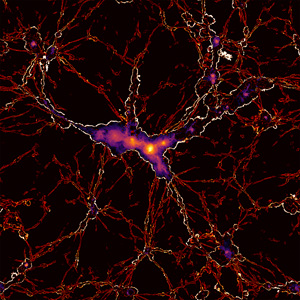
D. Nelson
Composite image combining the predicted x-ray (free-free) emission from hot gas in halos (purple to orange) with the mach number of hydrodynamical shocks (from red to white, showing increasing strength). This view shows an extremely thin slice (only 100 pkpc thick) of the full TNG100-1 volume at z=0, centered on the second most massive cluster. Low mach number shocks at intergalactic filaments (red) converge into quasi-spherical, high mach number accretion shocks (white) which mark the boundaries between voids and gaseous halos. [large]
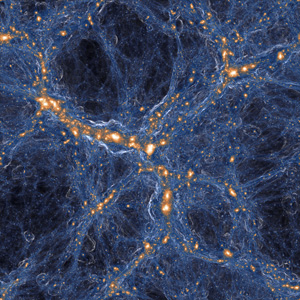
D. Nelson
Composite image (of the full TNG100-1 box) which overlays a projection of the dark matter density with the output of our on-the-fly cosmological shock finder, here used to derive the average mach number of shocks along each line of sight. All the gravitationally collapsed structures (in orange/white) are surrounded by successive shock surfaces (blue) which encode their formation histories. [large]
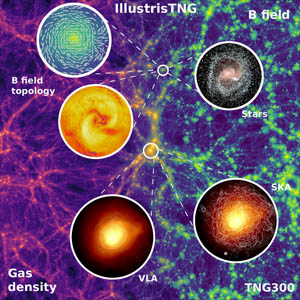
F. Marinacci
Gas density (left) and magnetic field strength (right) across the TNG300 box, centered on the most massive galaxy cluster. Zoomed panels show: magnetic field orientation and stellar light (top), or xray and radio emission from massive cluster (bottom). [large]
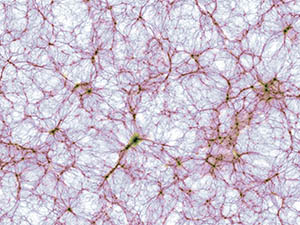
V. Springel
Thin slice through the cosmic large-scale structure in the TNG300 simulation of IllustrisTNG. Shown is a projection of the baryonic density field, where image brightness indicates the projected mass density and color hue visualizes the mean projected gas temperature. The displayed region extends by about 1.2 billion lightyears from left to right. [large]
TNG50 Videos:
Typically encoded in H.264 format for 1080p widescreen HD (1920x1080), H.265 for 4K widescreen UHD (3840x2160), and/or 2000x2000 for square movies.
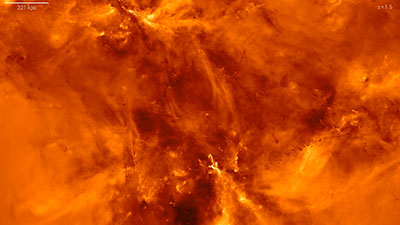
D. Nelson
The motion of cosmic gas in a small region of TNG50, color encoding velocity from at rest (black) to 1000 km/s (bright red and white). At early times, accretion and infall from the intergalactic medium coallesces in the centers of many small halos. Stellar feedback produces slow galactic winds which gradually push mass outwards, until several central blackholes become sufficiently massive to launch high-velocity outflows to large distance. Past redshift one, we switch to a view of the stellar distribution of this forming protocluster, revealing the process of the hierarchical assembly of structure and its signatures: stellar streams, shells, tidal tails, and merging galaxies. The binary coallesence of the two galactic nuclei occurs at z=0.15, sending spiral waves outwards into the ICL. (01:49) [4K version]

D. Nelson
The formation of a single large galaxy "g1" through time, from high redshift until the present day. This TNG50 galaxy will be similar in mass to Andromeda (M31) by redshift zero. Its progenitor experiences rapid star formation in a turbulent gas reservoir which settles into an ordered disk after z=2. A rather quiet late time assembly history without major mergers allows the galaxy to relax into an equilibrium balance of stellar feedback and gas accretion from its cooling circumgalactic medium. Insets show large-scale dark matter and then gas (lower left), and small-scale stellar and gaseous distributions (lower right). The main panel shows gas density, transitioning to gas metallicity during the brief pause and rotation. (01:59) [4K version] [clean, no text, only gas] [clean, no text, only stars] [clean, gas & stars]
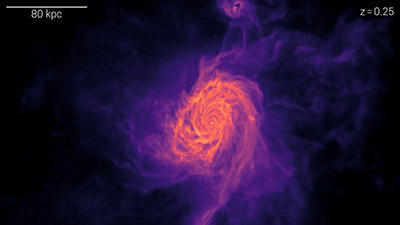
D. Nelson
Formation of a single galaxy "g3", tracked through time from high redshift until the present day. This relatively "average" TNG50 galaxy will be just slightly less massive than our own Milky Way at z=0. We include a large-scale view (lower left), and zoomed in views of the central gas and stellar structures (lower right), while the main panel shows projected gas density. At z=1.5 we pause and rotate around the system, showing in order: gas metallicity, gas velocity field, and H-alpha luminosity, before continuing. What is a small dwarf at high redshift (108.3 solar masses in stars at z=4) transitions, at late times, into a large stable disk with a quasi-steady star formation rate of a few solar masses per year. (02:35) [4K version]
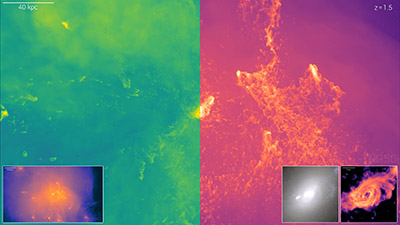
D. Nelson
The assembly of a single massive elliptical galaxy "g2" in TNG50, tracked through time. By redshift zero this system will merge into the BCG of a Virgo-mass galaxy cluster (1014 solar masses). The progenitor of this galaxy undergoes rapid star formation in a turbulent, extended disk until intermediate times, when it starts to quench due to the action of its central blackhole. Vigorous major and minor merger activity transforms it from a disk into an elliptical system; an extremely complex interplay of multi-phase gas processes in its circumgalactic medium is visible throughout. The inset in the lower left shows the large-scale environment, while insets in the lower right zoom into the central galaxy itself (gas and stars). We pause at z=1.5 and rotate around the inner halo, showing: gas metallicity, velocity field, radial velocity, and H-alpha light. We pause again at the end of the movie and show H-alpha light followed by magnetic field strength. (02:50) [4K version] [clean, only gas]

D. Nelson
A journey through the TNG50 simulation at redshift zero, the present day. Spanning 30 Mpc from top to bottom, the animation scrolls through the entire virtual Universe exactly one time, without repeating any region. As time progresses, we see the: dark matter distribution, gas mass distribution, Lyman-alpha emission, gas temperature, gas velocity, stellar mass distribution, x-ray emission, gas-phase metallicity, cosmic shock mach number, rate of energy dissipation in shocks, magnetic field strength, and finally OVII column density. (02:48) [4K version] [5120x1440 ultra-wide version]
Videos:
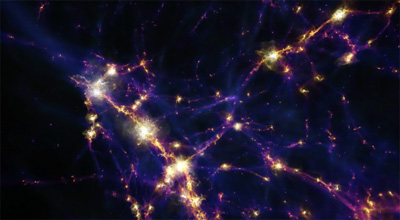
M. Vogelsberger
The interstellar magnetic field strength: blue/purple shows regions of low magnetic energy arranged along filaments of the cosmic web, while orange and white show regions with significant magnetic energy inside halos and galaxies. Time evolution of the inside of a 10Mpc (comoving) region within TNG100-1 from the start of the simulation to z=0. (01:45) [4K version]
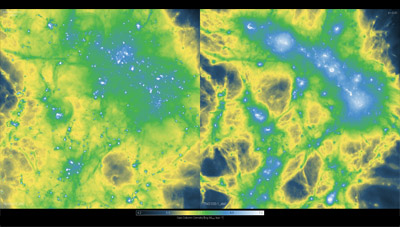
D. Nelson
Comparison of the distribution of intergalactic gas (mass), between TNG100-1 and Illustris-1. Low-density voids (black/dark blue) transition to cosmic filaments (yellow/green), gas halos (light blue) and individual galaxies (white). The time evolution of the exact same 10Mpc (comoving) region is compared between the two simulations, which distribute gas differently on large scales as a result of the differences in the galaxy formation models. (01:37) [4K version]
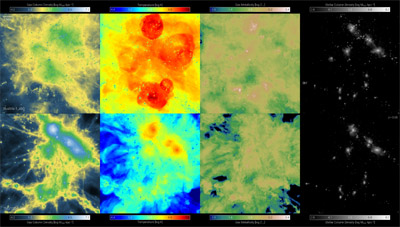
D. Nelson
Comparison of four properties of intergalactic matter between the TNG100-1 and Illustris-1 simulations. These are (left to right): gas density, gas temperature, the abundance of heavy elements (metallicity), and the distribution of stars. The time-synchronized evolution of the same 10Mpc (comoving) region is compared between the two simulations. (01:37) [4K version]
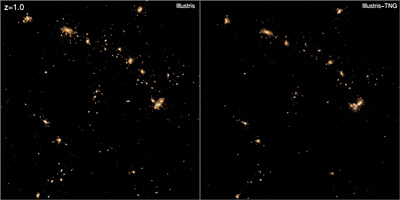
S. Genel
Contrasting the large-scale distribution of stellar light between the original Illustris simulation (on the left) and the analogous TNG100 simulation (on the right). The same 10Mpc (comoving) region is shown between the two simulations, and because these were run with the same "phases" of the initial conditions, the same individual galaxies form in the same regions of space, allowing object-by-object comparison. (01:14) [4K version]
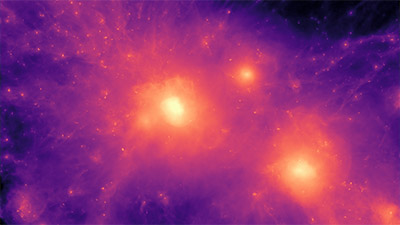
D. Nelson
The formation of the most massive galaxy supercluster in TNG300, starting from 500 million years after the Big Bang and progressing to the present day. By redshift zero, this galaxy cluster has a total mass just exceeding 1015 times the mass of our sun, and represents one of the most massive objects in the Universe. The visualization depicts physical gas density, from low-density cosmic voids (black) to the highest density central core of the cluster (white). (01:11) [4K version]
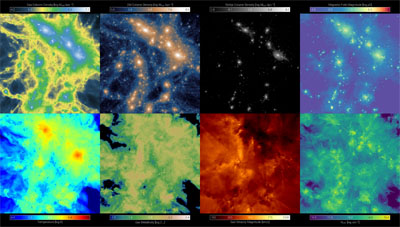
D. Nelson
Eight views: the evolving structure of a small 10Mpc region of cosmic space is visualized from TNG100-1. Each view shows a different output of the simulation (from left to right, top): gas matter density, dark matter density, stellar mass, magnetic field strength, (bottom) gas temperature, gas metallicity, the velocity field of the gas, and column density of OVI - the fifth ionization state of oxygen (O5+). Each view shows the same region of space, all of these components co-evolving together as the simulation runs. (01:37) [4K version]
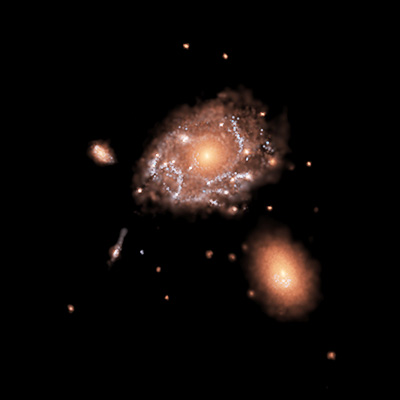
S. Genel
Formation of a massive "late-type", star-forming disk galaxy: an individual system is tracked through time, and its stellar light is shown in a 500 kilo-parsec region. This galaxy exhibits rapid ongoing star formation in an extended, clumpy disk, until it experiences a late-time merger (at approximately z ~ 0.3) with a nearly equal mass companion. (01:24)
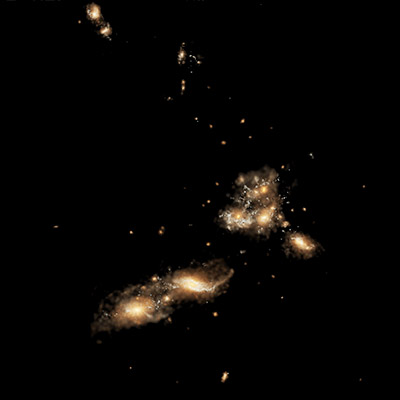
S. Genel
Formation of an "early-type", quiescent elliptical galaxy: an individual galaxy is tracked through time, and its stellar light is shown in a 1 mega-parsec region. Between the start of the movie at high redshift and the end at z=0 (present day), this massive "red-and-dead" galaxy experiences a large number of galaxy mergers which bring in stars and other material, building up the final spheroidal morphology. (02:23)

F. Marinacci
The most massive cluster of TNG300 at z=0 (with a halo mass of ~ 1015 times the mass of the sun). Fixed in time, the video slowly rotates in space to show the structure from different view points. Each of the four panels shows the same predicted X-ray emission (in background color), while the overlaid contours show the predicted synchrotron emission, as would be observed by one of four radio telescopes: VLA, LOFAR, ASKAP, or SKA. (00:32)
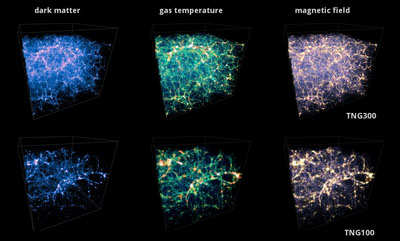
M. Vogelsberger
Full simulation cubes of TNG300 (on the top) and TNG100 (on the bottom), showing dark matter, gas temperature, and magnetic field strength, all at the present day (z=0). Fixed in time, the movie shows the full matter distribution being built up by slowly adding slices from the bottom of each cube to the top. (00:58)
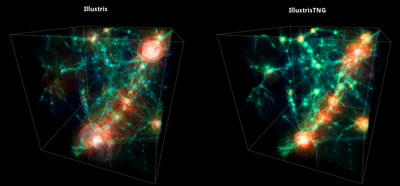
M. Vogelsberger
Time evolution of a 10Mpc (comoving) cubic region, rendered from outside. The movie shows the gas temperature (blue: cold, green: warm: white: hot), comparing original Illustris (left) to TNG100 (right). In both cases, the rapid temperature fluctuations and outbursts around nodes in the cosmic web are due to various energetic "feedback" processes in the simulation. These include energy from stars (supernovae explosions) as well as heat and high-velocity winds from supermassive black holes. (01:48)
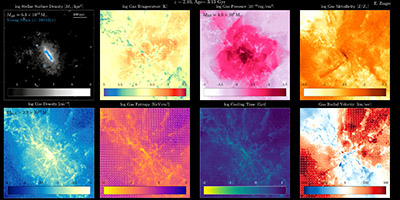
E. Zinger
Evolution of a single, central galaxy in TNG100 from early times to the present day. Emphasis is placed on the impact of feedback, particularly black hole feedback, on the properties of the gas around this galaxy, i.e. in its circumgalactic medium. We show: stellar surface density, gas temperature, pressure, metallicity, density, entropy, cooling time, and radial velocity. This galaxy reaches a final stellar mass of 2 x 1011 solar masses. (0:55)
Additional Images:
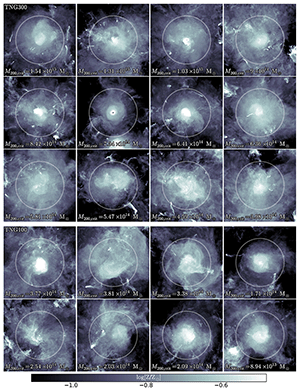
M. Vogelsberger
Projected metallicity maps for the twelve most massive clusters of TNG300 (top) and the eight most massive clusters of TNG100 (bottom) at redshift zero. Each image is three times the virial radius in extent, and the circles show the virial radii. Gas with significant environment of heavy elements is spread out to large distances away from the cluster central galaxy. [large]
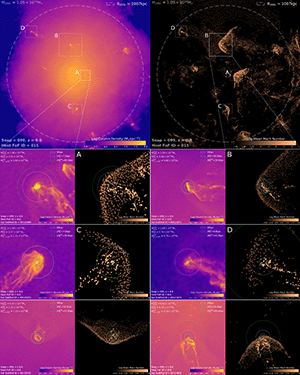
K. Yun
Jellyfish galaxies and their bowshocks in TNG100. Gas density projections (purple/orange) and corresponding maps of Mach number (brown) in a grou-mass halo. The Mach number reveals well-defined bow shocks in front of galaxies with clear evidence for ram-pressure stripping. The bow shocks are remarkably extended, significantly moreso than the galactic bodies, and cover large areas of the projected cluster volume. [large]
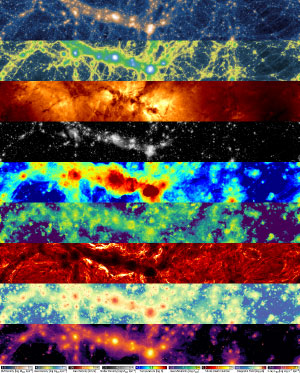
D. Nelson
Overview of the wide variety of physical information accessible in the different matter components of the TNG simulations. From top to bottom: dark matter density, gas density, gas velocity field, stellar mass density, gas temperature, gas-phase metallicity, shock mach number, magnetic field strength, and x-ray luminosity. Each panel shows a view of the same cuboid (110x14x37 Mpc) volume of TNG100-1 at redshift zero, cutting across a swath of large-scale structure. [large]
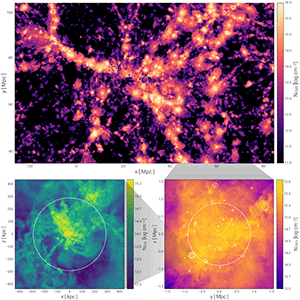
D. Nelson
The distribution of highly ionized oxygen in the TNG100 simulation at redshift zero. On the top: the column density of OVII tracing the large-scale cosmic web of filaments and collapsed halos. Lower right: we zoom onto a small galaxy cluster with a total mass of about 1014 times the mass of the sun, showing its OVIII column - the highest observable ion of oxygen. Lower left: we further zoom onto the scale of a small group, slightly more massive than the Milky Way, and show the OVI column density (virial radii as white circles). [large]
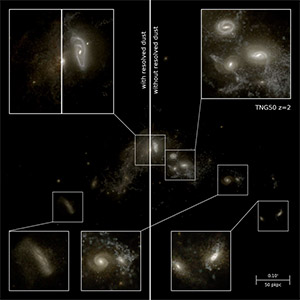
M. Vogelsberger
The optical light from stars within a forming protocluster at redshift two in the TNG50 simulation. Here the impact of a sophisticated post-processing model for dust absorption and scattering (on the left) is contrasted against the intrinsic light that the stellar populations emit (on the right). Each of the zoom-in panels show individual galaxies marked within the larger field of view. [large]

A. Pillepich
Gallery of hydrodynamical shocks, on the scale of individual dark matter halos, drawn from across the TNG50, TNG100, and TNG300 simulations. A mixture of feedback-driven shocks propagate outwards, while infalling satellite galaxies produce bow shocks while passing through the ICM of galaxy clusters. [large]
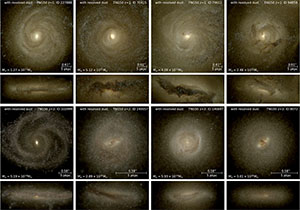
M. Vogelsberger
Mock stellar light images of eight TNG50 galaxies, face-on and edge-on, as would be seen in apparent F115W, F150W, and F200W filters of the James Webb Space Telescope (JWST). All renderings include the impact of dust absorption and scattering using a Monte Carlo radiative transfer post-processing of the simulation itself. The appearence and particularly light from centrally bright regions is significantly affected by the presence of dust. The top four panels show four z=1 systems with a dust-to-metal ratio of 0.3, while the bottom four panels show four z=2 systems with a dust-to-metal ratio of 0.9. [large]
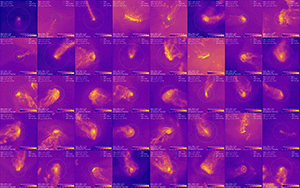
K. Yun
A gallery of forty "jellyfish" galaxies from TNG100. These are all satellite galaxies residing in massive groups and clusters at low redshift which display, in these gas density projections, clear evidence for gasdynamical environmental effects. Namely, ram-pressure stripping, which produces asymmetric, elongated gas distributions and tails extending far beyond the bodies of the satellite galaxies themselves. [large]
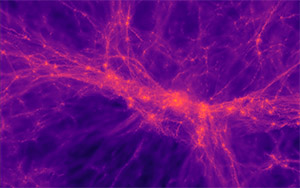
R. Weinberger
The large-scale structure of cosmic gas in the early Universe, at redshift three. The image shows a a region of space 15 Mpc across, where the cosmic web of gas filaments come together to fuel the growth of galaxies. Within these structures of the intergalactic medium small-scale turbulence and density structure is seen at the resolution of TNG50. [large]
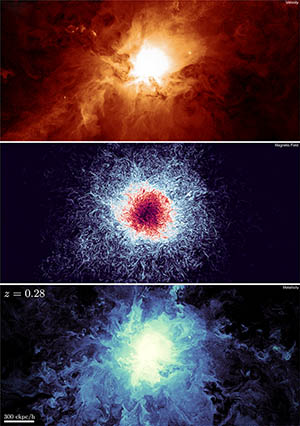
M. Fournier
Three views of the most massive cluster in the TNG50 simulation, at a redshift of z=0.28 when the halo was three billion years younger than at the present day. At redshift zero, this cluster will resemble Virgo, with a dark matter halo mass of 1014.3 Msun. Three thin slices are shown (from top to bottom): gas velocity, magnetic field strength, and metallicity. The depth of the slices are 40, 4, and 20 ckpc/h, respectively. Small-scale turbulent motions give rise to complex structure. [large]
